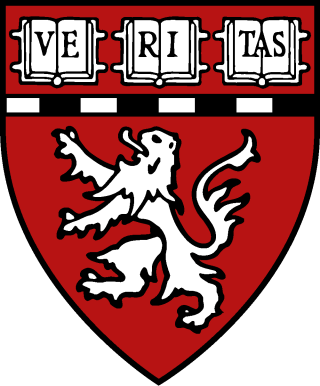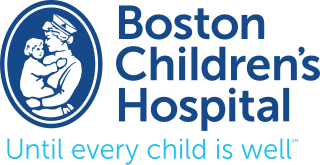
Harvard Medical School (HMS) is the medical school of Harvard University and is located in the Longwood Medical Area in Boston, Massachusetts. Founded in 1782, HMS is one of the oldest medical schools in the United States, and provides patient care, medical education, and research training through its 15 clinical affiliates and research institutes, including Massachusetts General Hospital (MGH), Boston Children's Hospital, Dana–Farber Cancer Institute, Brigham and Women's Hospital, Beth Israel Deaconess Medical Center, Mount Auburn Hospital, McLean Hospital, Cambridge Health Alliance, The Baker Center for Children and Families, Spaulding Rehabilitation Hospital, and others

Rheumatic fever (RF) is an inflammatory disease that can involve the heart, joints, skin, and brain. The disease typically develops two to four weeks after a streptococcal throat infection. Signs and symptoms include fever, multiple painful joints, involuntary muscle movements, and occasionally a characteristic non-itchy rash known as erythema marginatum. The heart is involved in about half of the cases. Damage to the heart valves, known as rheumatic heart disease (RHD), usually occurs after repeated attacks but can sometimes occur after one. The damaged valves may result in heart failure, atrial fibrillation and infection of the valves.

Beth Israel Deaconess Medical Center (BIDMC) in Boston, Massachusetts is a teaching hospital of Harvard Medical School and one of the founding members of Beth Israel Lahey Health. It was formed out of the 1996 merger of Beth Israel Hospital and New England Deaconess Hospital. Among independent teaching hospitals, Beth Israel Deaconess Medical Center has ranked in the top three recipients of biomedical research funding from the National Institutes of Health. Research funding totals nearly $200 million annually. BIDMC researchers run more than 850 active sponsored projects and 200 clinical trials. The Harvard-Thorndike General Clinical Research Center, the oldest clinical research laboratory in the United States, has been located on this site since 1973.

Massachusetts General Hospital is a teaching hospital located in the West End neighborhood of Boston, Massachusetts. It is the original and largest clinical education and research facility of Harvard Medical School/Harvard University, and houses the world's largest hospital-based research program with an annual research budget of more than $1.2 billion in 2021. It is the third-oldest general hospital in the United States with a patient capacity of 999 beds. Along with Brigham and Women's Hospital, Mass General is a founding member of Mass General Brigham, formerly known as Partners HealthCare, the largest healthcare provider in Massachusetts.

Boston Children's Hospital is the main pediatric training and research hospital of Harvard Medical School, Harvard University. It is a nationally ranked, freestanding acute care children's hospital located at the centre of Harvard Longwood Medical and Academic Area in Boston, Massachusetts. The hospital is home to the world's largest pediatric research enterprise, and it is the leading recipient of pediatric research funding from the National Institutes of Health (NIH). It provides comprehensive pediatric specialties and subspecialties to infants, children, teens, and young adults aged 0–21 throughout Massachusetts, the United States, and the world. The hospital also sometimes treats adults that require pediatric care. The hospital uses the Brigham and Women's Hospital's rooftop helipad and is an ACS verified level I pediatric trauma center, one of three in Boston. The hospital features a regional pediatric intensive-care unit and an American Academy of Pediatrics verified level IV neonatal intensive care unit. Boston Children's Hospital has been ranked as best pediatric medical center by U.S. News & World Report more times than any other hospital and is currently ranked as the best children's hospital in the United States. Its research enterprise is the world's largest and most highly funded pediatric hospital. In the 2022 fiscal year, it received more funding from the National Institutes of Health (NIH) than any other children's hospital in the nation. Boston Children's Hospital was ranked #1 in U.S. News & World Report's 2024-25 Best Children’s Hospitals Honor Roll, marking its tenth consecutive year in the #1 position. The hospital was also rated #1 in the 2025 "World's Best Specialized Hospitals" list for pediatrics by Newsweek.

Brigham and Women's Hospital is the second largest teaching hospital of Harvard Medical School and the largest hospital in the Longwood Medical Area in Boston, Massachusetts. Along with Massachusetts General Hospital, it is one of the two founding members of Mass General Brigham, the largest healthcare provider in Massachusetts. Giles Boland, MD, serves as the hospital's current president.

The Tufts University School of Medicine is the medical school of Tufts University, a private research university in Massachusetts. It was established in 1893 and is located on the university's health sciences campus in downtown Boston. It has clinical affiliations with numerous doctors and researchers in the United States and around the world, as well as with its affiliated hospitals in both Massachusetts, and Maine.

The Boston City Hospital (1864–1996), in Boston, Massachusetts, was a public hospital located in the South End. It was "intended for the use and comfort of poor patients, to whom medical care will be provided at the expense of the city, and ... to provide accommodations and medical treatment to others, who do not wish to be regarded as dependent on public charity."

Boston Medical Center (BMC) is a non-profit 514-bed academic medical center and safety-net hospital in the South End neighborhood of Boston, Massachusetts. As part of the Boston Medical Center Health System, the hospital provides primary and specialty care to residents of the Greater Boston area. It is also the principal teaching hospital of Boston University Chobanian & Avedisian School of Medicine and home to 66 residency and fellowship training programs.
Hans E. Einstein was the foremost authority on the lung disease Valley Fever. He lived in Bakersfield, California. He was a first cousin, twice removed, of physicist Albert Einstein, as Hans's grandfather and Albert were first cousins.

Barbara Mary Ansell was a British medical doctor and the founder of the field of paediatric rheumatology. Ansell was notable for outstanding contributions to the advancement of paediatric knowledge, specifically defining chronic joint disorders and the improvement of their management.
La Rabida Children's Hospital is a small pediatric specialty hospital for extended acute care that caters to children with lifelong medical conditions. Located on the South Side of Chicago on Lake Michigan, the facility is designed to showcase its lakeside views. La Rabida serves approximately 9,000 children annually who require primary and specialty care to address complex and challenging medical conditions. The hospital provides care to all patients regardless of the family's ability to pay. Services and programs include treatment for chronic illnesses such as asthma, diabetes, sickle cell disease, and developmental disabilities. In addition, La Rabida specializes in the treatment of children who have been abused, neglected or experienced trauma.
David Davis Rutstein (1909-1986) was a long-time faculty member at Harvard Medical School and an advocate for preventive medicine. He was one of the first physicians to use television as an outreach tool to inform the public about health concerns and research. Rutstein also played a national role in the organization of medical care in the United States, the integration of preventive medicine into patient care, and the measurement of medical outcomes.

The German Center for Pediatric and Adolescent Rheumatology in Garmisch-Partenkirchen is the largest specialized center for the treatment of children and adolescents with rheumatic diseases and chronic pain syndromes in Europe.
Rufus Wyman (1778–1842) was an American physician. He was the first physician and superintendent of the Asylum for the Insane, renamed in 1823 to McLean Hospital, part of the Massachusetts General Hospital system, and the first mental hospital in the state.
Sujoy Bhushan Roy was an Indian cardiologist and the founder Head of the department of the Cardiology at the All India Institute of Medical Sciences, Delhi. He was the president of the Cardiological Society of India in 1972. He was known for medical research in cardiology and was reported to have coined the name, Juvenile Rheumatic Stenosis. The Government of India awarded him the third highest civilian honour of the Padma Bhushan, in 1972, for his contributions to medical science.

The Edinburgh City Hospital was a hospital in Colinton, Edinburgh, opened in 1903 for the treatment of infectious diseases. As the pattern of infectious disease changed, the need for in-patients facilities to treat them diminished. While still remaining the regional centre for infectious disease, in the latter half of the 20th century the hospital facilities diversified with specialist units established for respiratory disease, ear, nose and throat surgery, maxillo-facial surgery, care of the elderly and latterly HIV/AIDS. The hospital closed in 1999 and was redeveloped as residential housing, known as Greenbank Village.
Thomas Duckett Jones was an American physician, cardiologist, and leading expert on rheumatic fever and rheumatic heart disease. He is known for the "Jones criteria" in the diagnosis of rheumatic fever. Jones's diagnostic criteria are still in use, although with multiple modifications.

Channing Home was an American "home-hospital". It was not a hospital in the common definition of the word, but a home for women whose death seemed quite certain and required constant medical attendance. Located in Boston, Massachusetts, the Home was established in 1857, and incorporated in 1861. It was founded by Harriet Ryan Albee through the assistance of rich women friends whom she had drawn into sympathy with her charitable purpose.













